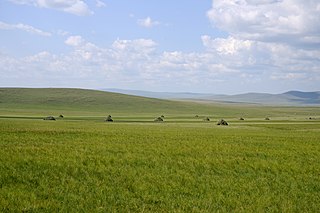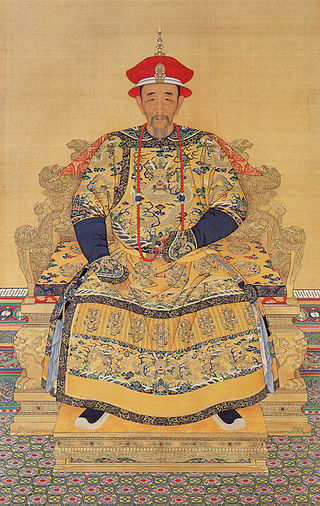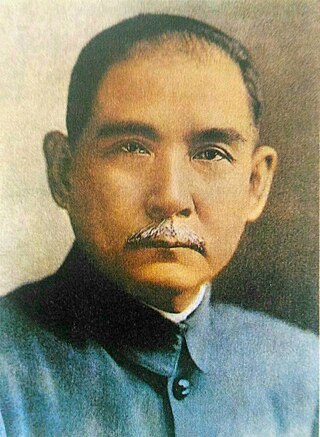| |||||
| Decades: | |||||
|---|---|---|---|---|---|
| See also: | Other events of 1675 History of China • Timeline • Years | ||||
Events from the year 1675 in China .
| |||||
| Decades: | |||||
|---|---|---|---|---|---|
| See also: | Other events of 1675 History of China • Timeline • Years | ||||
Events from the year 1675 in China .

The Qing dynasty, officially the Great Qing, was a Manchu-led imperial dynasty of China and the last imperial dynasty in Chinese history. It emerged from the Later Jin dynasty founded by a Tungusic-speaking ethnic group who became known as the Manchus. The dynasty was officially proclaimed in 1636 in Mukden, and following the Battle of Shanhai Pass it seized control of Beijing in 1644, which is often considered the start of the dynasty's rule in China. Within decades the Qing had consolidated its control over the whole of China proper and Taiwan, and by the mid-18th century it had expanded its rule into Inner Asia. The dynasty lasted until 1912 when it was overthrown in the Xinhai Revolution. In Chinese historiography, the Qing dynasty was preceded by the Ming dynasty and succeeded by the Republic of China. The multiethnic Qing dynasty assembled the territorial base for modern China. It was the largest imperial dynasty in the history of China and in 1790 the fourth-largest empire in world history in terms of territorial size. With 419,264,000 citizens in 1907, it was the most populous country in the world at the time.

Inner Mongolia, officially the Inner Mongolia Autonomous Region, is an autonomous region of the People's Republic of China. Its border includes two-thirds of the length of China's border with the country of Mongolia. Inner Mongolia also accounts for a small section of China's border with Russia. Its capital is Hohhot; other major cities include Baotou, Chifeng, Tongliao, and Ordos.
The Eight Banners were administrative and military divisions under the Later Jin and Qing dynasties of China into which all Manchu households were placed. In war, the Eight Banners functioned as armies, but the banner system was also the basic organizational framework of all of Manchu society. Created in the early 17th century by Nurhaci, the banner armies played an instrumental role in his unification of the fragmented Jurchen people and in the Qing dynasty's conquest of the Ming dynasty.

The Chahars are a subgroup of Mongols that speak Chakhar Mongolian and predominantly live in southeastern Inner Mongolia, China.

The Kangxi Emperor, also known by his temple name Emperor Shengzu of Qing, personal name Xuanye, was the third emperor of the Qing dynasty, and the second Qing emperor to rule over China proper, reigning from 1661 to 1722.

Hong Taiji, also rendered as Huang Taiji and sometimes referred to as Abahai in Western literature, also known by his temple name as the Emperor Taizong of Qing, was the second khan of the Later Jin dynasty and the founding emperor of the Qing dynasty. He was responsible for consolidating the empire that his father Nurhaci had founded and laid the groundwork for the conquest of the Ming dynasty, although he died before this was accomplished. He was also responsible for changing the name of the Jurchen ethnicity to "Manchu" in 1635, and changing the name of his dynasty from "Great Jin" to "Great Qing" in 1636. The Qing dynasty lasted until 1912.
Soni (1601–1667), also known as Sonin, and rarely Sony, was a Manchu noble of the Hešeri clan who served as one of the Four Regents of the Kangxi Emperor during the Qing dynasty (1644–1912). His clan belonged to the Plain Yellow Banner.

The Revolt of the Three Feudatories, also known as the Rebellion of Wu Sangui, was a rebellion in China lasting from 1673 to 1681, during the early reign of the Kangxi Emperor of the Qing dynasty (1644–1912). The revolt was led by the three lords of the fiefdoms in Yunnan, Guangdong and Fujian provinces against the Qing central government. These hereditary titles had been given to prominent Han Chinese defectors who had helped the Manchu conquer China during the transition from Ming to Qing. The feudatories were supported by Zheng Jing's Kingdom of Tungning in Taiwan, which sent forces to invade Mainland China. Additionally, minor Han military figures, such as Wang Fuchen and the Chahar Mongols, also revolted against Qing rule. After the last remaining Han resistance had been put down, the former princely titles were abolished.
Wei Zhouzuo (1612–1675), courtesy name Wenxi, art name Wenshi, was an official who served in the late Ming dynasty and early Qing dynasty. He was a native of Chengnei (城內). He took the imperial examination and obtained a jinshi degree in 1637 during the reign of the Chongzhen Emperor.
Erke Khongghor, alternatively known as Ejei, (?–1641) was the last khagan of the Northern Yuan dynasty, ruling briefly from 1634 to 1635. He was the son of Ligdan Khan. The Northern Yuan dynasty, which existed as remnants of the Yuan dynasty retreating north to the Mongolian Plateau after 1368, was defeated by the Later Jin dynasty in 1635 and thus formally came to an end.

Mongolia under Qing rule was the rule of the Manchu-led Qing dynasty of China over the Mongolian Plateau, including the four Outer Mongolian aimags and the six Inner Mongolian aimags from the 17th century to the end of the dynasty. The term "Mongolia" is used here in the broader historical sense, and includes an area much larger than the modern-day state of Mongolia. Ligdan saw much of his power weakened due to the disunity of the Mongol tribes. He was subsequently defeated by the Later Jin dynasty and died soon afterwards. His son Ejei handed the Yuan imperial seal over to Hong Taiji in 1635, thus ending the rule of the Northern Yuan dynasty in Inner Mongolia. However, the Khalkha Mongols in Outer Mongolia continued to rule until they were overrun by the Dzungar Khanate in 1690, and they submitted to the Qing dynasty in 1691.

Anti-Qing sentiment refers to a sentiment principally held in China against the rule of the Manchu-led Qing dynasty (1636–1912), which was criticized by opponents as being "barbaric". The Qing was accused of destroying traditional Han culture by enforcing policies such as forcing Han to wear their hair in a queue in the Manchu style. It was blamed for suppressing Chinese science, causing China to be transformed from the world's premiere power to a poor, backwards nation. The people of the Eight Banners lived off government pensions unlike the general Han civilian population.

The Northern Yuan was a dynastic regime ruled by the Mongol Borjigin clan based in the Mongolian Plateau. It existed as a rump state after the collapse of the Yuan dynasty in 1368 and lasted until its conquest by the Jurchen-led Later Jin dynasty in 1635. The Northern Yuan dynasty began with the retreat of the Yuan imperial court led by Toghon Temür to the Mongolian steppe. This period featured factional struggles and the often only nominal role of the Great Khan.
The Deliberative Council of Princes and Ministers, also known as the Council of Princes and High Officials and Assembly of Princes and High Officials, or simply as the Deliberative Council, was an advisory body for the emperors of the early Qing dynasty (1636–1912). Derived from informal deliberative groups created by Nurhaci (1559–1626) in the 1610s and early 1620s, the Council was formally established by his son and successor Hong Taiji (1592–1643) in 1626 and expanded in 1637. Staffed mainly by Manchu dignitaries, this aristocratic institution served as the chief source of advice on military matters for Hong Taiji and the Shunzhi and Kangxi emperors. It was particularly powerful during the regencies of Dorgon (1643–1650) and Oboi (1661–1669), who used it to enhance their personal influence.
The history of the Qing dynasty began in 1636, when Manchu chieftain Hong Taiji officially proclaimed the Qing dynasty, although the year 1644 is often considered the start of the dynasty's rule in China. The dynasty lasted until 1912, when Puyi abdicated the throne in response to the Xinhai Revolution in 1911. The final imperial dynasty of China, the Qing dynasty reached heights of power unlike any of the Chinese dynasties which preceded it, engaging in large-scale territorial expansion which ended with embarrassing defeat and humiliation to the foreign powers whom they believe to be inferior to them. The Qing dynasty's inability to successfully counter Western and Japanese imperialism ultimately led to its downfall, and the instability which emerged in China during the final years of the dynasty ultimately paved the way for the Warlord Era.
Anti-Mongol sentiment has been prevalent throughout history, often perceiving the Mongols to be barbaric and uncivilized people with a lack of intelligence or civilized culture.
Events from the year 1669 in China.
Events from the year 1674 in China.
Events from the year 1683 in China.
Gurun Princess Wenzhuang, personal name Makata (馬喀塔), was a princess of the Qing dynasty. She was a daughter of Hong Taiji born by his Mongol wife, Empress Xiaoduanwen.